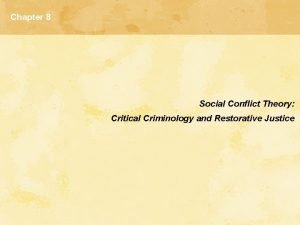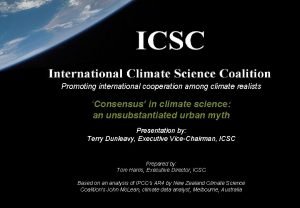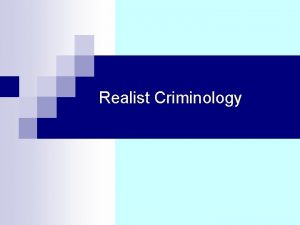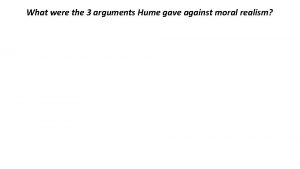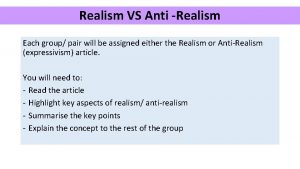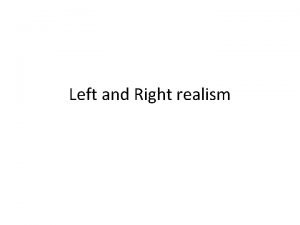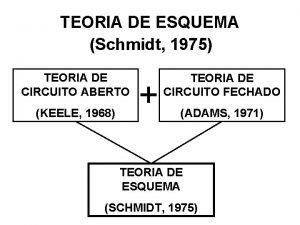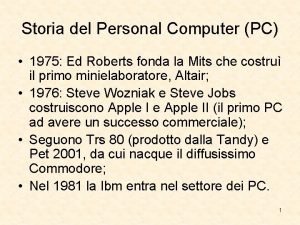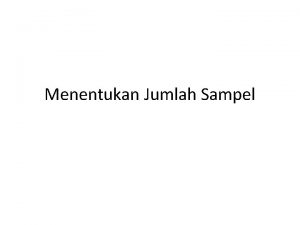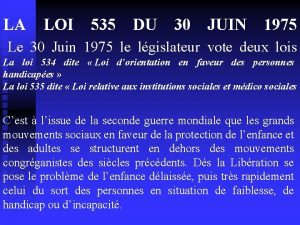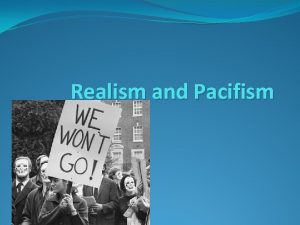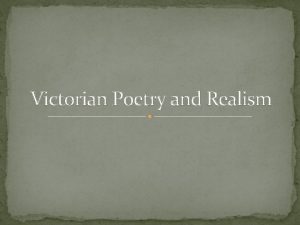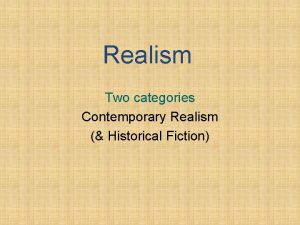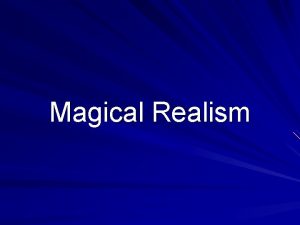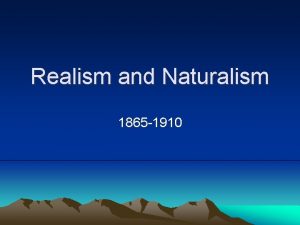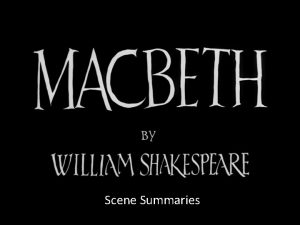Realism study summaries Right Realists 1 Wilson 1975















- Slides: 15

Realism study summaries

Right Realists 1. Wilson (1975) 2. Wilson and Kelling (1982) 3. Wilson and Herrnstien (1985) 4. Charles Murray 5. Ron Clarke- Rational Choice Theory

Wilson (1975) Challenges mainstream criminology In particular challenges Marxist criminology, for being based on ideology rather than facts. He argues the morals of society must be upheld, and trying to understand justify criminology is not desirable. Wilson argues long term trends in crime can be accounted for by three factors 1. Young males are the group most likely to commit crime, because they are temperamentally aggressive and have short term horizons 2. There may be changes to the benefits and costs of crime over time, due to accessibility, the economy and availability of jobs- this will change the rate of which crime occurs, especially property crime 3. Broad social and cultural changes in society which are reinforced by the family, media and religion, may influence general norms and values, which in turn may affect certain ‘at risk’ individuals who are tempted into deviance or conform to norms

Wilson and Kelling (1982) Use Broken Windows article on Padlet - Use Ipad Wilson and Kelling (1982) – essential to maintain local areas to prevent crime taking place – any sign of deterioration must be dealt with immediately They advocate ZERO TOLERANCE towards undesirable behaviour such as prostitution, drunkenness and begging. The role of the police should be to focus on controlling the streets so that law-abiding citizens are safe.

Wilson and Herrnstien (1985) • Wilson and Herrnstein (1985) – biosocial theory of crime – a combination of biological and social factors. • Biological difference make some more predisposed to crime – aggression, extroversion, risk taking. • Herrnstein and Murray (1994) argue the main cause of crime is low intelligence which they see as being biologically determined.

Charles Murray • • Effective socialisation reduced the risk of offending – self-control, right from wrong. The best agency is the FAMILY. Murray (1990) – crime is rising due to the growth of an underclass who are defined by their deviant behaviour and fail to socialise their children properly. The underclass is growing in the US and USA due to the culture of welfare dependency. Decline in marriage, growth of OPF, reduced responsibility for the family – no need to work Lone parent mothers – ineffective agents of socialisation, especially for boys. Absent fathers –lack parental discipline and male role models so they turn to alternative delinquent role models to gain status through crime. Bennett, Dilulio and Walters (1996) crime is the result of “growing up surrounded by deviant and criminal adults…designed to produce vicious, predatory street criminals. The underclass threatens social cohesion as it undermines the values of hard work and personal responsibility.

Ron Clarke- Rational Choice Theory • Individuals have free will and the power of reason. • Ron Clarke (1980) committing crime is a CHOICE based on a rational calculation of the likely consequences. • If the rewards outweigh the risk then people will be more likely to offend. • RR – cost of crime is perceived to be low – this is why the crime rate has increased

Left Realists 1. Young (1986) 2. Young (1999) 3. Lea and Jock Young (1993) 4. Matthews and Young 5. Kinsey, Lea and Young

Young (1986) • It is important for LR to navigate between two extremes 1. The hysteria about the underclass, media driven moral panics and over-policing of certain crimes in certain areas 2. The denial of the severity of street crime and its impacts (LR such as Marxists and radical criminologists) and the romantic view of the criminal. Robin Hood thesis

Lea and Jock Young (1993) • • • Lea and Young believe deprivation will only lead to crime where it is experienced as relative deprivation. A group experiences relative deprivation when it feels deprived in comparison to other similar groups, or when its expectations are not met. It is not the fact of being deprived as such, but the feeling of deprivation which is important. Relative depravation has increased in the UK over the last 20 years. The second key concept Lea and Young use is that of subculture. They see subcultures as the collective solution to a group’s problems. Thus, if a group of individuals share a sense of relative deprivation, they will develop lifestyles which allow them to cope with this problem. However, a particular subculture is not an automatic, inevitable response to a situation; Human creativity will allow a variety of solutions to be produced. The third and final key concept is that of marginalization. Marginal groups are those which lack organizations to represent their interests in political life, and which also lack clearly defined goals. Lea and Young argue that marginal groups in society are particularly prone to the use of violence and riots as forms of political action.

Young (1999) • Young later developed Lea and Young (1993) concepts (Read this before you look at Young’s developments) • He developed the concepts of relative deprevation and marginalisation, focusing on the way society economically excludes increasing numbers of people, and drawing a link between social exlusion and crime • As economic exclusion increases this leads to social exclusion, the breakdown of famililes and communities and an increase in crime and disorder • This creates a culture of fear, which can lead to scapegoating and even more social divisions • Young’s biggest concern is that this is leading to a less tolerant society with harsher reactions to the excluded

Matthews and Young LR aims to be a total explanation of crime, combining all the strengths of previous theories in a way which will encourage social policies to combat crime to emerge. LR’s believe that their theory can help understand the entire range of crime by combining both structure and action. • Young, Lea & Matthews ague that to truly understand crime, one must examine the interplay between both micro and macro factors in what they call “the square of crime”. When examining a crime, one must consider the 4 following aspects; • The state – as an agent of formal social control, the state decide what is “criminal” and what is not. It is thus vital to consider them when explaining crime, as all crimes happen in the context of the state. We must also consider social forces that influence the police, and a number of LR’s have investigated the effects of different styles of policing on crime levels. • Offender – it is also vital to consider why people offend. What motivates them, and what makes them continue to commit crime? LR’s argue that more research is needed into the “trajectory of crime” – in order to investigate why people drift in and out of criminal behaviour. • The public – we must consider the factors that influence public attitudes and responses to crime. This has become one of the most important areas of study, as fear of stigmatisation from peer groups, family and neighbours is one of the most powerful determinants of behaviour. Cross referencing with the mass media, the newspapers/television have a massive ability to shape public perceptions of what is “criminal”, which causes us to apply certain labels to certain acts. • The victim – the victim must also be considered, as ultimately, they decide whether a crime has taken place. It is important to consider what makes victims vulnerable in both a macro (e. g. their position is society) and a micro (e. g. their relationships to the offender) sense. •

Kinsey, Lea and Young • How can police improve their performance and begin to clear up more crime? • Kinsey, Lea and Young argue the key to police success lies in improving relationships with the community so that the flow of information on which the police rely increases. • To achieve this, they propose that minimal policing should be used. Although he has argued that the public should establish priorities for the police, Jock Young has also identified areas which he believes are over-policed and under-policed. • In other words, he thinks that the police and the state devote too much of their time and energy to dealing with certain types of crime, and not enough to others. This ‘approach’ to policing distorts the stats as to the true nature of crime. Where crime is committed and who commits crime.

EVALUATION OF LEFT REALISM STRENGTHS WEAKNESSES Drawn from other existing Left realism offers a theories. Not so much as a refreshing alternative to breakthrough as a “pulling existing theories of crime, together” of ideas, sometimes although in doing so has failing to acknowledge the gathered its enemies. origins of the work. Has developed in complexity, but has not “delivered the Hughes also points out a goods” in the form of number of strengths however; empirical research. How good is a theory if it can’t be tested? Left realism avoids the worst LR falls back on a traditional excesses of both left and definition of crime – a right wing approaches by definition which Marxists neither glorifying nor argue is constructed by the attacking the police. state for its own benefit. Hughes argues that LR fails LR explores the role of the to explain street crime, and victim in much more depth that LR’s have failed to than any other criminological gather sufficient evidence on theory. the motives of criminals.

Study summary Sociologist: Summary of sociologist study What would your sociologist suggest we should do to tackle crime and deviance? Write a short summary of policies influenced by this sociologist for you manifesto
 Right product right place right time right price
Right product right place right time right price Right time right place right quantity right quality
Right time right place right quantity right quality Social conflict criminology
Social conflict criminology Climate realists
Climate realists Realist criminology
Realist criminology The right man on the right place at the right time
The right man on the right place at the right time No moral
No moral Realism vs anti realism
Realism vs anti realism Realism vs anti realism
Realism vs anti realism Left realism
Left realism Schmidt 1975
Schmidt 1975 Personal computer 1975
Personal computer 1975 Who invented blotting technique in 1975? *
Who invented blotting technique in 1975? * Jumlah sampel minimal penelitian korelasi
Jumlah sampel minimal penelitian korelasi Loi 75-535 du 30 juin 1975
Loi 75-535 du 30 juin 1975 La industria española entre 1855 y 1975
La industria española entre 1855 y 1975


